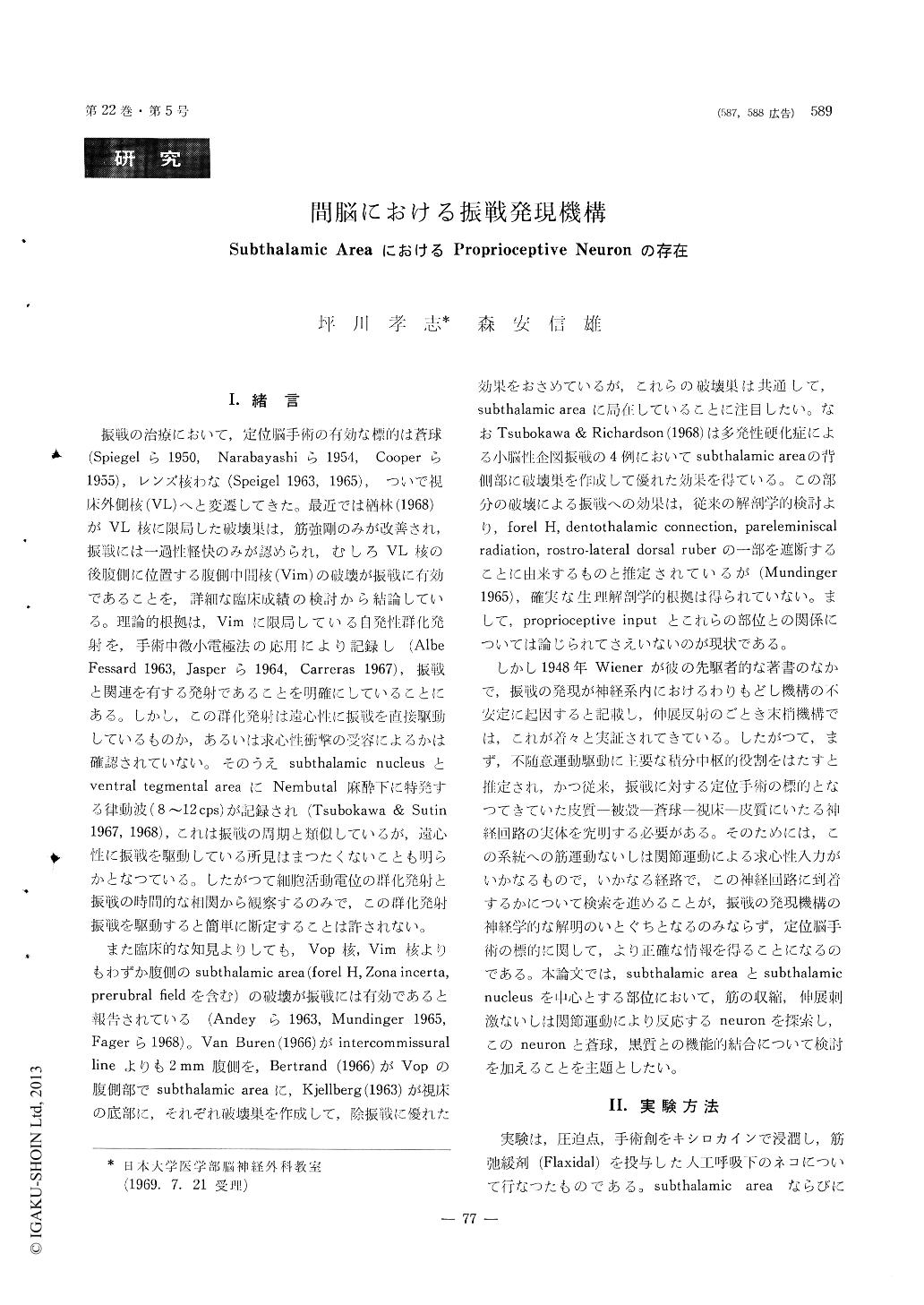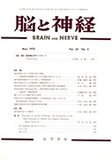Japanese
English
- 有料閲覧
- Abstract 文献概要
- 1ページ目 Look Inside
I.緒言
振戦の治療において,定位脳手術の有効な標的は蒼球(Spiegelら1950, Narabayashiら1954, Cooperら1955),レンズ核わな(Speigel 1963, 1965),ついで視床外側核(VL)へと変遷してきた。最近では楢林(1968)がVL核に限局した破壊巣は,筋強剛のみが改善され,振戦には一過性軽快のみが認められ,むしろVL核の後腹側に位置する腹側中間核(Vim)の破壊が振戦に有効であることを,詳細な臨床成績の検討から結論している。理論的根拠は,Vimに限局している自発性群化発射を,手術中微小電極法の応用により記録し(AlbeFessard 1963, Jasperら1964, Carreras 1967),振戦と関連を有する発射であることを明確にしていることにある。しかし,この群化発射は遠心性に振戦を直接駆動しているものか,あるいは求心性衝撃の受容によるかは確認されていない。そのうえsubthalamic nucleusとventral tegmental areaにNembutal麻酔下に特発する律動波(8〜12cps)が記録され(Tsubokawa & Sutin1967, 1968),これは振戦の周期と類似しているが,遠心性に振戦を駆動している所見はまったくないことも明らかとなつている。したがって細胞活動電位の群化発射と振戦の時間的な相関から観察するのみで,この群化発射振戦を駆動すると簡単に断定することは許されない。
また臨床的な知見よりしても,Vop核,Vim核よりもわずか腹側のsubthalamic area (forel H, Zona incerta,prerubral fieldを含む)の破壊が振戦には有効であると報告されている(Andeyら1963, Mundinger 1965,Fagerら1968)。Van Buren (1966)がintercommissurallineよりも2mm腹側を,Bertrand (1966)がVopの腹側部でsubthalamic areaに,Kjellberg (1963)が視床の底部に,それぞれ破壊巣を作成して,除振戦に優れた効果をおさめているが,これらの破壊巣は共通して,subthalamic areaに局在していることに注目したい。なおTsubokawa & Richardson (1968)は多発性硬化症による小脳性企図振戦の4例においてsubthalamic areaの背側部に破壊巣を作成して優れた効果を得ている。この部分の破壊による振戦への効果は,従来の解剖学的検討より,forel H, dentothalamic connection, pareleminiscalradiation, rostro-lateral dorsal ruberの一部を遮断することに由来するものと推定されているが(Mundinger1965),確実な生理解剖学的根拠は得られていない。まして,proprioceptive inputとこれらの部位との関係については論じられてさえいないのが現状である。
The effect of joint movement, touch, pressure, nocieption and peripheral nerve stimulation upon the discharge of the neurons of subthalamic area and subthalamic nucleus were examined under local anesthetized and artificially respirated cat. Later in the experiment, sodium pentobarbiturate was given and its effect upon the neuron was studied. Single unit activity was recorded with microelectrode. Limb movement was accomplished either manually or through a lever arrangement after fixing the pro-ximal limb joint.
1) The neurons responding to joint movement were recorded in the zona incerta and fields H1 and H2 of Forel. All of these neurons also responded to electrical stimulation bilateral peripheral nerve. No subthalamic neurons were found to respond to stimulation of the sural nerve, nor did they respond to nociceptive, tactile or pressure stimulation of the limbs.
2) The most frequently observed responding pat-tern, found in 84% of the cells sampled, was an on-response. The other neurons showed an on-off response, an arrest type response and complicated response.
3) The receptie field of these neurons are large and sometime covered all joint of the limbs.
4) The neurons responded to joint movement have not any fiber connection from the pallidum, but 28% of tested neurons responed to stimulation of the substantia nigra.
5) Under the nembutal anesthesia, the neurons were never responded to joint movement.
6) According to lesion expriments, this neuron get input from peripheral nerve through the cerebellum.
7) In the subthalamic nucleus, the neuron res-ponded to joint movement was not found and there was large difference neurophysiological property from the neurons of subthalamic area.
According to these results, the new proprioceptive afferent system through the cerebellum was found in the subthalamic area and this input system might has an important role to control extrapyramidal moter system.

Copyright © 1970, Igaku-Shoin Ltd. All rights reserved.


